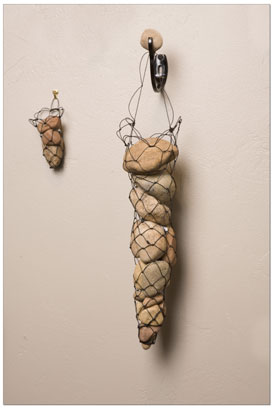|
| ||
| A pinch of sexuality
by Jules Masterjohn When Georgia O’Keeffe presented her flower paintings for the first time in the late 1920s, many viewers and critics interpreted them as sexual and erotic. The artist stated that she had no thoughts of expressing sexuality when she made the paintings, intending instead to simply show what interested her most about a blossom – the small and often overlooked inner botanical details. In response, O’Keeffe stated, “Well, I made you take time to look at what I saw, and when you took time to really notice my flower, you hung all your own associations with flowers on my flower and you write about my flowers as if I think and see what you think and see, and I don’t.” Flowers are “clearly an erotic sexual symbol” states Eugene Glynn, art historian and psychotherapist, in a September 2006 article in ARTnews magazine. Countering his own conclusion about a flower image, Glynn goes on to state that it is difficult to know “when it is a symbol or allegory and when it is a real thing painted for itself.” It seems, then, that the best authority on the meaning of an image is the artist herself. And yet, are artists always aware of their intentions when creating? Who is responsible for the interpretation of a work of art? Visual communication is a complex situation where the sender (artist) and receiver (viewer) may never meet to define their terms and confirm the message, yet a rich exchange can exist. To make matters even more interesting, some artists trust that a specific image will elicit multiple meanings for the viewer, given its cultural or historical context. Renaissance painting in northern Europe was filled with iconography that was understood by educated persons of that day; though today, a lily portrayed in a painting may or may not be understood to signify purity, as it did back then. Artist Robert Mapplethorpe played with multiple associations when he used photographs of calla lilies during the 1980s as symbols of purity as well as stand-ins for male genitalia. The public did recognize his reference to male anatomy, but this was due to his other body of photographs depicting nude males. Layers of symbolic representation act like visual poetry, where an image conjures up many and even contradictory associations. Art, alone, can be a bubbling cauldron in America: add a pinch of sexuality and the pot may easily boil over, burning some and feeding others. It seems that sexual interpretation of art is guaranteed in our culture, where suggestive advertising hooks our attention daily. In our visually overloaded world, the viewer brings an immense amount of information and experience to a work of art. Both conscious and unconscious information filters through art making and art viewing. While displaying my sculptural installation called “Touchstones” recently, I was reminded of this. The night the show opened, a few women shared with me that they thought the piece looked phallic. Later, someone offered in writing, “The rocks in the wire encasements remind me of relationships with different men, different sizes, different times and spaces in life. The almighty penis!” I was totally perplexed by this interpretation. The shape of the male organ never entered my mind as I crafted the 11 wire baskets filled with smooth river rocks that hung from the gallery wall. Clearly these dangling rock and wire forms touched something inside various individuals that I, as maker, did not consciously intend. As I tried to see what they saw as phallic, I did get the reference but only as limp male members. The initial idea for crafting the specific basket shape was based on a memory from my childhood, a remembrance filled with innocence and playfulness. When I was in grade school, my friends and I would fashion funnel-shaped baskets out of paper, fill them with lilacs, and deliver them anonymously on May Day to each of our neighbors’ front doors. Too, as I worked on weaving the wire baskets and filling them with rocks, a secondary idea emerged, one that references gravity’s effect on the female anatomy. The different pointy-shaped hanging baskets began to remind me of pendulous breasts, implying grounding – weight and ballast – that can come with living into one’s middle years. I was thinking of the crone’s wisdom and prehistoric female figurines as I filed the baskets with well-worn rocks. Having once been mountains themselves, river rocks suggest the journey of time, and reference the earth connection. Making and sharing art is the realm of alchemy. The artist begins the brew with intention, by using ideas, images and materials. Into the potion is added the final ingredient – not the eye of newt but the eye of the beholder. This last addition transforms the artist’s base elements into something more than the artist had intended, possibly something with more value than could have ever been anticipated. •
|


